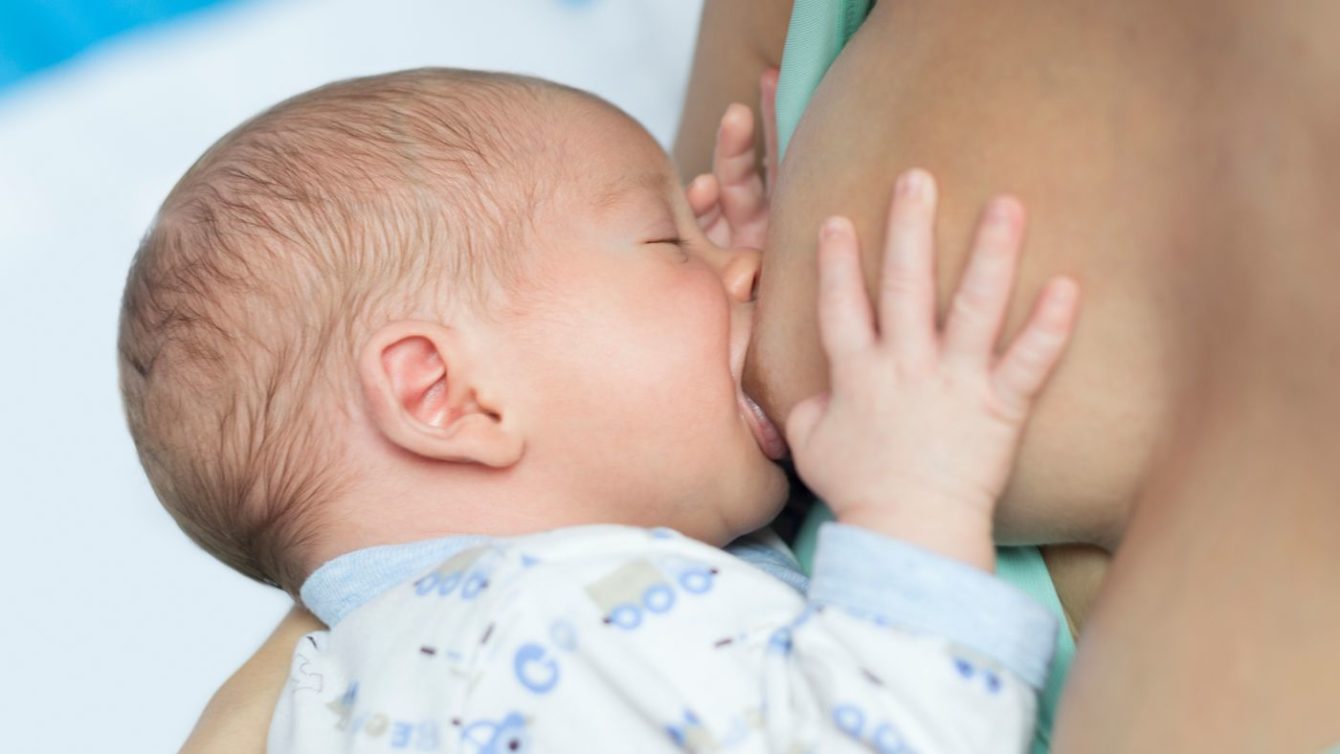Nipple shapes and sizes can vary a lot from woman to woman. Read our practical tips to help make breastfeeding a little easier – whatever type of nipples you have.
Most women’s nipples protrude and become more erect when stimulated by touch or sensation, but some have nipples that are flat or inverted. And some women have had one or both nipples pierced. Many mums with inverted, flat, or pierced nipples breastfeed with no problems at all, but others need extra support.
“Don’t panic if you have flat or inverted nipples, it’s often perfectly possible to breastfeed,” reassures Sioned Hilton, a lactation consultant, neonatal nurse and health visitor, who has worked with Medela in the UK for more than a decade. “Remember your baby latches on to a mouthful of breast, not only the nipple itself, when feeding effectively.”
But in the earliest days, when your baby’s mouth is still tiny and her sucking is less efficient, inverted or flat nipples may make it harder for her to start – particularly if she is premature or unwell.
“If your nipple is flat or inverted, it may not reach the roof of your baby’s mouth to stimulate her palate and trigger her sucking reflex,” Sioned explains. “This could mean she has problems latching, or can’t stayed latched on for effective milk transfer.”
How to tell if you have flat or inverted nipples
Flat nipples1 don’t protrude very far from the areola (the darker area surrounding them), even when stimulated.
An inverted nipple dimples inwards at the centre. It may look like this all the time, or only when stimulated. Sometimes inverted nipples retract back so they are level with the areola, or they may even sink down into the breast tissue.
One or both nipples can be affected, and it’s estimated up to 10% of first-time mums have at least one inverted nipple.2 If you’re not sure whether your nipple is inverted, try the ‘pinch test’: compress your breast gently, with your thumb and forefinger either side of the areola. Most nipples will poke out, but if yours retracts or pulls inwards, creating a hollow at the end, then it’s inverted.
Preparing inverted or flat nipples during pregnancy
You may find that, as your breasts change during pregnancy, your nipples begin to protrude more by themselves. If not, and you’re concerned that their shape could make breastfeeding difficult, you can wear nipple formers. These soft, flexible silicone discs fit discreetly inside your bra and place gentle pressure on your nipples, helping draw them out.
“Nipple formers can be worn from week 32 of a normal pregnancy,” advises Sioned. “Start with just an hour a day and build up to around eight hours. If you have an incompetent (weakened) cervix or are otherwise at risk of delivering pre-term, chat to a healthcare professional about the best time to start using them, as nipple stimulation can bring on contractions.
“You can continue to wear the nipple formers once your baby is born,” she adds. “Try popping them inside your bra 30 to 60 minutes before you’re due to breastfeed.”
“I have inverted nipples and, after two or three weeks of trying to get my baby to latch, was on the verge of switching to formula,” remembers Nina, mum of one, Germany. “I sought help from La Leche League and a lovely lady visited and encouraged me to keep going. She suggested nipple formers, which really helped. Somehow my little boy started to understand what to do! Breastfeeding was then great and we kept going until he was 21 months old.”
Helping your baby latch on to flat or inverted nipples
If your baby will suck happily on your finger but seems less interested in your breast, it’s a sign your nipple may not be reaching her palate when she latches on. She may become frustrated and pull away and cry, or even fall asleep at your breast. If this is happening, ask a lactation consultant or breastfeeding specialist to check her latch.
There are several techniques you can use just before each breastfeed to form your nipples into an easier shape for your baby to latch on to. Sioned suggests:
- rolling your nipple between your thumb and forefinger to encourage it to stick out
- compressing your breast just behind your areola with your fingers in a ‘V’ or ‘C’ shape to push your nipple outwards
- touching your nipple briefly with a cold compress or ice cube to make it erect
- hand expressing or using a breast pump for a couple of minutes before a feed to pull your nipple out more
“I have one flat nipple, but only found out when Austin had difficulty feeding on that side,” says Jennifer, mum of two, UK. “There’s nothing anatomically wrong – it just doesn’t perk up as much, which makes the latch a bit trickier. Before feeding on that side I always tweaked and squeezed it a bit and eased it into his mouth. It was a bit tricky early on but got a lot easier as time passed.”
Using a nipple shield to help baby latch on
If none of the above work and your baby is still struggling to maintain her latch, your lactation consultant or breastfeeding specialist may advise you to feed your baby through a nipple shield. This is a thin, flexible piece of silicone, shaped like a nipple, with holes in the tip for your milk to pass through.
The nipple shield offers your baby a larger, firmer target, as well as stimulating her palate to encourage her to suck. In general nipple shields should be considered as a short-term solution. If problems or pain occur, consult your lactation consultant or breastfeeding specialist, who will ensure your baby is latching well with the shield in place. You’ll also need to monitor your baby’s weight gain to ensure your milk supply is building to meet her needs.3
Over time, as your baby’s suck gets stronger and your nipples become more accustomed to breastfeeding, you might be able to breastfeed without the nipple shields.
“My nipples are rather flat. A healthcare professional recommended nipple shields for my two babies, and I used them with great success,” says Anne-Sophie, mum of two, Sweden. “My secret to make them stick to the skin is to wet the edge slightly before use.”
Breastfeeding with pierced nipples
Many women with pierced nipples find it has no impact on their ability to breastfeed – although you’ll need to remove jewellery before feeds as it’s a choking hazard and could graze your baby’s tongue, gums or palate.
“I had a nipple piercing, but removed it a year later when I got pregnant as my breasts felt sensitive,” says Kellie, mum of three, UK. “I breastfed my daughter exclusively, and then her two younger brothers, with no issues whatsoever. If anything, the pierced nipple was the favourite!”
Other mums find breast milk leaks from their piercing holes, or suspect scarring from the piercing is reducing their milk supply4 – although there has been limited research in this area.
“It’s impossible to know how a piercing will affect breastfeeding until your milk comes in,” says Sioned. “Get advice from a lactation consultant or breastfeeding specialist if you’re worried. And remember babies can get all the nutrition they need from just one breast if there’s a problem with the other.”
If you can’t breastfeed with flat or inverted nipples
If you’ve tried everything and breastfeeding’s just not working, you still need to feed your baby.
“The most important thing is a well mum and baby,” says Sioned. “Exclusive pumping, so your baby has expressed milk at every feed, might work for you. Or you could try a supplemental nursing system so your baby can practise feeding from your breast while being topped up with expressed milk through a tube. This means she still gets the breastfeeding experience and stimulates your milk supply, which in turn may help you express more milk.”
“I have inverted nipples. After a disastrous breastfeeding experience with my first son, I was determined to succeed with my second,” says Babettli, mum of two, Italy. “I got advice from experts and tried nipple formers and nipple shields, but without success. In the end pumping exclusively using a hospital-grade Medela Symphony double electric breast pump was the best option for us. I pumped every feed for four months.”
Caring for different types of nipples
You may need to take extra care of your flat or inverted nipples as your baby might suck on them more strongly, which could make them sore at first. For tips on combatting sore nipples, read nipple care for breastfeeding mums.
If your nipples retract after feeding, any dampness could make them sore and increase the risk of infections, including thrush. Pat them dry after a feed before they have the chance to sink back.
Flat and inverted nipples can be harder to deal with if your breasts are engorged – when even nipples that are usually erect can temporarily flatten. Read our article on breast engorgement for advice.
The great news is that repeated breastfeeding or pumping can alter your nipple form, so breastfeeding might get easier as your baby grows. And you may not have any problems at all if you have another baby – as Leanne, mum of two, UK, found:
“Second time round breastfeeding was a dream,” she says. “Nearly four months of expressing for my first son had helped stretch out my flat nipples and my second son latched straight away without nipple shields. He’s still feeding now at nine months.”
- Pluchinotta AM. The Outpatient Breast Clinic. Springer International Publishing; 2015.
- Alexander JM, Campbell MJ. Prevalence of inverted and non-protractile nipples in antenatal women who intend to breast-feed. The Breast. 1997;6(2):72-78.
- McKechnie AC, Eglash A. Nipple shields: a review of the literature. Breastfeeding Medicine. 2010;5(6):309-314.
- Garbin CP, Deacon JP, Rowan MK, Hartmann PE, Geddes DT. Association of nipple piercing with abnormal milk production and breastfeeding. JAMA, Journal of the American Medical Association. 2009;301(24):2550-2551.
























